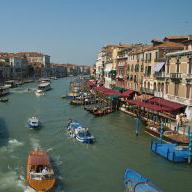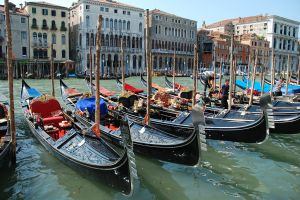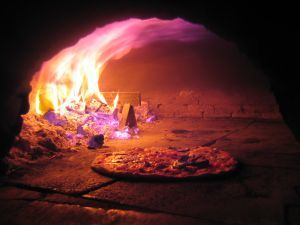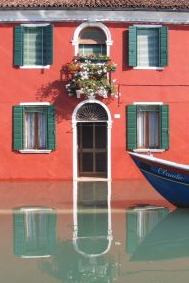 From the moment you step off a train at the Stazione Centrale, you’ll be derailed by Venice’s beauty.
From the moment you step off a train at the Stazione Centrale, you’ll be derailed by Venice’s beauty.
Rather than roads jam-packed with cars and pedestrians, this city is known for gondolas softly treading the water set against lines of aged structures that even the best painting couldn’t capture on canvas.
Venice is a city with its own distinct personality, charm and grace, both on and off the brochure.
The good news is that Venice is accessible in ways that are easy on the pocket. In fact, if you skip the touristy areas, you’ll find that many of the city’s hidden gems cost next to nothing and offer a truly genuine Venetian experience.
Check out more of our Off the Brochure Travel Guides:
View Off the Brochure Maps in a larger map
GETTING AROUND
If you really want more for your money, skip the overpriced gondola ride for a more scenic tour on the vaporetto, a water bus that charges a measly €6. Besides the savings of up to €80, you get a view of the entire city center that the gondola rides don’t offer.
 However, for those who really want the experience of riding on the iconic Venetian boat, there is still the traghetti: old gondolas stripped of traditional furnishings and rowed by two oarsmen. These boats travel across the Grand Canal, meaning that the view is not as panoramic as the vaporetto, but it is equally dramatic. Amazingly, only three bridges cross the canal, but you can catch a traghetto at any of its seven stops. The ride costs mere pocket change—about half a euro.
However, for those who really want the experience of riding on the iconic Venetian boat, there is still the traghetti: old gondolas stripped of traditional furnishings and rowed by two oarsmen. These boats travel across the Grand Canal, meaning that the view is not as panoramic as the vaporetto, but it is equally dramatic. Amazingly, only three bridges cross the canal, but you can catch a traghetto at any of its seven stops. The ride costs mere pocket change—about half a euro.
EATING LIKE A VENETIAN
One thing you won’t worry about in Venice: food. Good food—from cheap eats to gourmet cuisine—can be found all over the city.
Of course, in Venice, there’s the classic choice, the pizzeria. And, why not? For less than €5, you can taste the local flavor without emptying your wallet.
Though its location—under the wooden Accademia Bridge next to the Grand Canal—may seem like a tourist trap, Pizzeria Accademia offers surprisingly tasty and inexpensive pizza. Best of all, you won’t be rushed out to make room for the next batch of customers. You can linger as long as you want, which, considering the view, is a plus.
 Hidden in one of Venice’s countless alleys, Pizzeria Ai Sportivi isn’t easy to find, but worth it if you want huge, delicious pizzas. Located in the Dorsoduro district at the southern end of the Campo Santa Margerita, the pizzeria may be lacking on the view, but its pizzas have enough flavor to draw in the customers. On top of this, Pizzeria Ai Sportivi is of the rare places in Venice that doesn’t charge a coperto (a cover charge).
Hidden in one of Venice’s countless alleys, Pizzeria Ai Sportivi isn’t easy to find, but worth it if you want huge, delicious pizzas. Located in the Dorsoduro district at the southern end of the Campo Santa Margerita, the pizzeria may be lacking on the view, but its pizzas have enough flavor to draw in the customers. On top of this, Pizzeria Ai Sportivi is of the rare places in Venice that doesn’t charge a coperto (a cover charge).
If you’re on a budget, steer clear of restaurants and fill up on tramezzini—small sandwiches—that are cheap and portable. They are sold at most all of the bars and cafes in Venice, even at gelato shops. One good stop is Enoteca do Colonne at 1814 Cannaregio, which serves sandwiches filled with the usual prosciutto or salami and also the unusual—like musetto (pork snout) and nerveti (boiled veal tendons).
Check out the bacari, which are wine bars that serve small plates known as cicheti (similar to tapas). Like the meals, a bottle of wine from these shops is usually inexpensive. Near the Rialto Bridge, in Campo San Giacometto, try the Bancogiro, with plenty of selections and another good view of the Grand Canal.
If you want to get away from the crowd of visitors, at San Lio you’ll find the Osteria al Portego, a small, but warm osteria that is popular among the locals and have few tourists. The bacaro is very traditional—eat cicheti at the counter and wash it down with wine, which is poured from real wooden barrels!
CLANDESTINE CHURCHES
Many have criticized that art in Venice is not well-shown, even in the high-end galleries. But, what they don’t realize is that the city is the canvas itself and that the most amazing artwork is preserved inside Venice’s basilicas. Plus, the best part of visiting these churches is that most of them don’t charge a dime!
 Not quite as popular as Piazza San Marco, the Santa Maria della Salute Church is a great place to absorb the beauty of Venice without having to wait in long lines or fight dirty pigeons from landing on your head. Santa Maria della Salute is just one vaporetto away from Pontile di San Marco. Here, you can sit peacefully on the square’s steps in front of the basilica with a marvelous view on the Bacino di San Marco.
Not quite as popular as Piazza San Marco, the Santa Maria della Salute Church is a great place to absorb the beauty of Venice without having to wait in long lines or fight dirty pigeons from landing on your head. Santa Maria della Salute is just one vaporetto away from Pontile di San Marco. Here, you can sit peacefully on the square’s steps in front of the basilica with a marvelous view on the Bacino di San Marco.
Its architect, Baldassare Longhena (1598-1682), constructed Santa Maria della Salute according to the Baroque style, which is unlike any other cathedral in Venice. Inside, the church is octagonal with six chapels and its floors are covered in stunning ceramic tiles. While you’re not allowed to step on the tiles, you can get a good shot of them walking along the sides.
San Pantalon (aka Chiesa di San Pantaleone Martire) is a memorial dedicated to Saint Pantaleon, a martyr and healer from Nicomedia (present day Izmit in Turkey). The church was founded early in the city’s history and famous for the painting, “The Martyrdom and Apotheosis of St. Pantaleon,” which is the largest painting on canvas in the world and covers the entire ceiling. The painter, Gian Antonio Fumiani actually died falling off the scaffolding and is buried in the church.
Inside, you can find other remarkable paintings, which include the Trecento masterpiece “Madonna of the Poppy” by Paolo Veneziano, and “St. Pantaleon healing a Boy” or “Conversion of St. Pantaleon,” probably the last work of the famous artist Paolo Veronese.
Offering one-of-a-kind views, the church of San Giorgio Maggiore is located on the island from where its name is derived. To get here, take the motoscafo 82 in S. Zaccharia and cross the Bacino of San Marco. At the basilica, you can get a grand view of the Venice landscape, which includes the island of Lido, the Adriatic Sea, and the line of Dolomites in the far distance!
Climb up the bell tower of the San Giorgio Maggiore Monastery, which has the best view of the church and the island. Afterwards, take a stroll through the monastery’s gardens, while appreciating the structure’s ancient architecture.
ISLAND OF COLOR
 If you desire a different scene, consider taking off to another island near Venice, called Burano. Located seven kilometers north of Venice, Burano is a tiny, relaxed island that is free of cars and full of tightly packed houses. Its intimate and brightly-colored architectural design differs from that of Venice, making it seem worlds away.
If you desire a different scene, consider taking off to another island near Venice, called Burano. Located seven kilometers north of Venice, Burano is a tiny, relaxed island that is free of cars and full of tightly packed houses. Its intimate and brightly-colored architectural design differs from that of Venice, making it seem worlds away.
To get to Burano, head to Venice’s Fondamenta Nuove and take the vaporetto lines 12 or 14. The ride is about 40 minutes long, so make sure you give yourself a day to fully enjoy this place. Try to get the seats on the deck to get a scenic tour while you ride.
A PERSONAL TALE: FELICE ANNO NUOVO, OR … WHEN NOT TO VISIT VENICE
I thought I knew what to expect when celebrating the holidays in Venice. I was wrong.
Things started out nicely. When the sun set on New Year’s Eve, my boyfriend and I splurged on our first gondola ride, and it was worth every (expensive) cent. As it turns out, while the city partied, the Grand Canal itself was quiet and uncrowded. All around us, the sunset cast a yellow undertone over the waters and buildings, setting a calm and peaceful scene.
Then we decided to go out for dinner … what a mistake.
Restaurants were packed with both locals and tourists while hungry crowds impatiently spilled into the streets. When we finally did get a table at Osteria Ca’ D’Oro, we got the worst service possible from waiters who tossed out “quality” in favor of “quantity.”
Ironically, they spent the first hour rushing us through our meal and then made us wait 40 minutes for the check. Fortunately, the manager was so hassled and overworked that when we voiced our complaints, he let us go without paying the bill. But free meal or not, it wasn’t worth the frustration of dining on New Year’s Eve in Venice.
We made another blunder by making our way to Piazza San Marco at 11:30 p.m. Though it started off joyously as we followed a train of revelers through the city’s narrow streets, things quickly came to a grinding halt.
When we finally reached the edge of the Piazza, we could go no further. Packed in like sardines, I could only stand helplessly while getting elbowed in the head in the crowd. Before the countdown had even started, people became increasingly agitated, until someone decided to pop a cork and spray the crowd with champagne. That’s when a small riot broke out.
Needless to say, my boyfriend and I got out of that mess as quickly as we could and enjoyed slivers of fireworks from the safe distance of our room.
By Sheena Pantaleon for PeterGreenberg.com.
Don’t miss the rest of our Off the Brochure Travel Guide Series. The series includes guide to Italian cities like Rome/Roma and Florence/Firenze as well as Parma and the Po River Valley.
Traveling to Italy for the Holidays? Here’s How Italians Celebrate.
Or learn about wintertime travels in Europe with ‘Tis the Season for Escaping to Europe.












